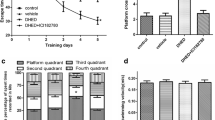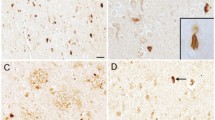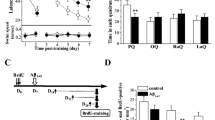Abstract
Protein kinase A (PKA) plays a crucial role in tau hyperphosphorylation, an early event of Alzheimer disease (AD), and 17β-estradiol replacement in aging women forestalls the onset of AD. However, the role of estradiol in PKA-induced tau hyperphosphorylation is not known. Here, we investigated the effect of 17β-estradiol on cAMP/PKA activity and the PKA-induced tau hyperphosphorylation in HEK293 cells stably expressing tau441. We found that 17β-estradiol effectively attenuated forskolin-induced overactivation of PKA and elevation of cAMP, and thus prevented tau from hyperphosphorylation. These data provide the first evidence that 17β-estradiol can inhibit PKA overactivation and the PKA-induced tau hyperphosphorylation, implying a preventive role of 17β-estradiol in AD-like tau pathology.




Similar content being viewed by others
Abbreviations
- AD:
-
Alzheimer’s disease
- NFT:
-
Neurofibrillary tangle
- HEK293:
-
Human embryonic kidney cell
- CCK-8:
-
Cell counting kit-8
- BCA:
-
Bicinchoninic acid
- PKA:
-
Protein kinase A
- PKAcα:
-
PKA catalytic subunit α
References
Grundke-Iqbal I, Iqbal K, Quinlan M, Tung YC, Zaidi MS, Wisniewski HM (1986a) Microtubule-associated protein tau. A component of Alzheimer paired helical filaments. J Biol Chem 261:6084–6089
Grundke-Iqbal I, Iqbal K, Tung YC, Quinlan M, Wisniewski HM, Binder LI (1986b) Abnormal phosphorylation of the microtubule-associated protein τ (tau) in Alzheimer cytoskeletal pathology. Proc Natl Acad Sci 83:4913–4917
Lee VM, Balin BJ, Otvos L Jr, Trojanowski JQ (1991) A68: a major subunit of paired helical filaments and derivatized forms of normal Tau. Science 251:675–678
Pant MK, Veeranna V, Amin ND, Amin N, Pant HC (1999) Phosphorylation activity in the Alzheimer’s disease and normal brain is modulated by microtubule-associated protein, tau in vitro. J Alzheimers Dis 1:169–182
Iqbal K, Alonso Adel C, El-Akkad E, Gong CX, Haque N, Khatoon S, Pei JJ, Tsujio I, Wang JZ, Grundke-Iqbal I (2002) Significance and mechanism of Alzheimer neurofibrillary degeneration and therapeutic targets to inhibit this lesion. J Mol Neurosci 19:95–99
Morishima-Kawashima M, Hasegawa M, Takio K, Suzuki M, Yoshida H, Watanabe A, Titani K, Ihara Y (1995a) Hyperphosphorylation of tau in PHF. Neurobiol Aging 16:365–380
Wang JZ, Wu Q, Smith A, Grundke-Iqbal I, Iqbal K (1998) Tau is phosphorylated by GSK-3 at several sites found in Alzheimer disease and its biological activity markedly inhibited only after it is prephosphorylated by A-kinase. FEBS Lett 436:28–34
Jicha GA, Weaver C, Lane E, Vianna C, Kress Y, Rockwood J, Davies P (1999) cAMP-dependent protein kinase phosphorylation on tau in Alzheimer’s disease. J. Neurosci 19:7486–7494
Robertson J, Loviny TL, Goedert M, Jakes R, Murray KJ, Anderton BH, Hanger DP (1993) Phosphorylation of tau by cyclic-AMP-dependent protein kinase. Dementia 4:256–263
Zhang Y, Li HL, Wang DL, Liu SJ, Wang JZ (2006) A transitory activation of protein kinase-A induces a sustained tau hyperphosphorylation at multiple sites in N2a cells-imply a new mechanism in Alzheimer pathology. J Neural Transm 113:1487–1497
Sun L, Wang X, Liu S, Wang Q, Wang J, Bennecib M, Gong CX, Sengupta A, Grundke-Iqbal I, Iqbal K (2005) Bilateral injection of isoproterenol into hippocampus induces Alzheimer-like hyperphosphorylation of tau and spatial memory deficit in rat. FEBS Lett 579:251–258
Liu SJ, Zhang JY, Li HL, Fang ZY, Wang Q, Deng HM, Gong CX, Grundke-Iqbal I, Iqbal K, Wang JZ (2004) Tau becomes a more favorable substrate for GSK-3 when it is prephosphorylated by PKA in rat brain. J Biol Chem 279:50078–50088
Filley CM (1997) Alzheimer’s disease in women. Am J Obstet Gynecol 176:1–7
Garcia-Segura LM, Azcoitia I, DonCarlos LL (2001) Neuroprotection by estradiol. Prog Neurobiol 63:29–60
Green PS, Simpkins JW (2000) Neuroprotective effects of estrogens: potential mechanisms of action. Int J Dev Neurosci 18:347–358
Lee SJ, McEwen BS (2001) Neurotrophic and neuroprotective actions of estrogens and their therapeutic implications. Annu Rev Pharmacol Toxicol 41:569–591
Wise PM, Dubal DB, Wilson ME, Rau SW, Liu Y (2001) Estrogens: trophic and protective factors in the adult brain. Front Neuroendocrinol 22:33–66
Behl C (2002) Oestrogen as a neuroprotective hormone. Nat Rev Neurosci 3:433–442
Gridley KE, Green PS, Simpkins JW (1997) Low concentrations of estradiol reduce β-amyloid (25–35)-induced toxicity, lipid peroxidation and glucose utilization in human SK-N-SH neuroblastoma cells. Brain Res 778:158–165
Goodman Y, Bruce AJ, Cheng B, Mattson MP (1996) Estrogens attenuate and corticosterone exacerbates excitotoxicity, oxidative injury, and amyloid β-peptide toxicity in hippocampal neurons. J Neurochem 66:1836–1844
Green PS, Gridley KE, Simpkins JW (1996) Estradiol protects against β-amyloid (25–35)-induced toxicity in SK-N-SH cells. Neurosci Lett 218:165–168
Mook-Jung I, Joo I, Sohn S, Kwon HJ, Huh K, Jung MW (1997) Estrogen blocks neurotoxic effects of beta-amyloid (1–42) and induces neurite extension of B103 cells. Neurosci Lett 235:101–104
Alvarez-de-la-Rosa M, Silva I, Nilsen J, Perez MM, Garcia-Segura LM, Avila J, Naftolin F (2005) Estradiol prevents neural tau hyperphosphorylation characteristic of Alzheimer’s disease. Ann NY Acad Sci 1052:210–224
Cardona-Gomez P, Perez M, Avila J, Garcia-Segura LM, Wandosell F (2004) Estradiol inhibits GSK3 and regulates interaction of estrogen receptors, GSK3, and beta-catenin in the hippocampus. Mol Cell Neurosci 25:363–373
Goodenough S, Schleusner D, Pietrzik C, Skutella T, Behl C (2005) Glycogen synthase kinase 3β links neuroprotection by 17β-estradiol to key Alzheimer processes. Neuroscience 132:581–589
Szendrei GI, Lee VM, Otvos L Jr (1993) Recognition of the minimal epitope of monoclonal antibody Tau-1 depends upon the presence of a phosphate group but not its location. J Neurosci Res 34:243–249
Ren QG, Liao XM, Chen XQ, Liu GP, Wang JZ (2007) Effects of tau phosphorylation on proteasome activity. FEBS Lett 581:1521–1528
Liu GP, Zhang Y, Yao XQ, Zhang CE, Fang J, Wang Q, Wang JZ (2007) Activation of glycogen synthase kinase-3 inhibits protein phosphatase-2A and the underlying mechanisms. Neurobiol Aging Epub ahead of print
Wang DL, Ling ZQ, Cao FY, Zhu LQ, Wang JZ (2004) Melatonin attenuates isoproterenol-induced protein kinase A overactivation and tau hyperphosphorylation in rat brain. J Pineal Res. 37:11–16
Casnellie JE (1991) Assay of protein kinases using peptides with basic residues for phosphocellulose binding. Methods Enzymol 200:115–120
Benzikri A (2000) Cerenkov counting. Health Phys 79:70–71
Seamon KB, Daly JW (1981) Forskolin: a unique diterpene activator of cyclic AMP-generating systems. J Cyclic Nucleotide Res 7:201–224
Senanarong V, Vannasaeng S, Poungvarin N, Ploybutr S, Udompunthurak S, Jamjumras P, Fairbanks L, Cummings JL (2002) Endogenous estradiol in elderly individuals: cognitive and noncognitive associations. Arch Neurol 59:385–389
Paganini-Hill A, Henderson VW (1994) Estrogen deficiency and risk of Alzheimer’s disease. Am J Epidemiol 140:256–261
Henderson VW (1997) The epidemiology of estrogen replacement therapy and Alzheimer’s disease. Neurology 48:527–535
Birge SJ (1997) The role of estrogen in the treatment of Alzheimer’s disease. Neurology 48:S36–S41
Cutter WJ, Craig M, Norbury R, Robertson DM, Whitehead M, Murphy DG (2003) In vivo effects of estrogen on human brain. Ann NY Acad Sci 1007:79–88
Ozen M, Karaahmet F, Tezcan ME, Bulut N, Altundag K (2007) Estrogen or testosterone may be effective agents in the management of both multiple myeloma and Alzheimer’s disease. Med Hypotheses 68:231–232
Behl C, Widmann M, Trapp T, Holsboer F (1995) 17-beta estradiol protects neurons from oxidative stress-induced cell death in vitro. Biochem Biophys Res Commun 216:473–482
Chang D, Kwan J, Timiras PS (1997) Estrogens influence growth, maturation, and amyloid beta-peptide production in neuroblastoma cells and in a beta-APP transfected kidney 293 cell line. Adv Exp Med Biol 429:261–271
Marin R, Guerra B, Hernandez-Jimenez JG, Kang XL, Fraser JD, Lopez FJ, Alonso R (2003) Estradiol prevents amyloid-beta peptide-induced cell death in a cholinergic cell line via modulation of a classical estrogen receptor. Neuroscience 121:917–926
Huse JT, Doms RW (2001) Closing in on the amyloid cascade: recent insights into the cell biology of Alzheimer’s disease. Mol Neurobiol 22:81–98
Braak E, Braak H, Mandelkow EM (1994) A sequence of cytoskeleton changes related to the formation of neurofibrillary tangles and neuropil threads. Acta Neuropathol (Berl) 87:554–567
Yi KD, Chung J, Pang P, Simpkins JW (2005) Role of protein phosphatases in estrogen-mediated neuroprotection. J Neurosci 25:7191–7198
Poderoso C, Paz C, Gorostizaga A, Maciel FC, Mendez CF, Podesta E (2002) Protein serine/threonine phosphatase 2A activity is inhibited by cAMP in MA-10 cells. Endocr Res 28:319–323
Shingo AS, Kito S (2005) Estradiol induces PKA activation through the putative membrane receptor in the living hippocampal neuron. J Neural Transm 112:1469–1473
Szego EM, Barabás K, Balog J, Szilágyi N, Korach KS, Juhász G, Abrahám IM (2006) Estrogen induces estrogen receptor α-dependent cAMP response element-binding protein phosphorylation via mitogen activated protein kinase pathway in basal forebrain cholinergic neurons in vivo. J Neurosci 26:4104–4110
Singh TJ, Haque N, Grundke-Iqbal I, Iqbal K (1995a) Rapid Alzheimer-like phosphorylation of tau by the synergistic actions of non-proline-dependent protein kinases and GSK-3. FEBS Lett 358:267–272
Liu F, Liang Z, Shi J, Yin D, El-Akkad E, Grundke-Iqbal I, Iqbal K, Gong CX (2006) PKA modulates GSK-3β- and cdk5-catalyzed phosphorylation of tau in site- and kinase-specific manners. FEBS Lett 580:6269–6274
Corbin JD, Sugden PH, West L, Flockhart DA, Lincon TM, McCarthy D (1978) Studies on the properties and mode of action of the purified regulatory subunit of bovine heart adenosine 3′:5′-monophosphate-dependent protein kinase. J Biol Chem 253:3997–4003
Builder SE, Beavo JA, Krebs EG (1980) The mechanism of activation of bovine skeletal muscle protein kinase by adenosine 3′:5′-monophosphate. J Biol Chem 255:3514–3519
Vulliet R, Halloran SM, Braun RK, Smith AJ, Lee G (1992) Proline-directed phosphorylation of human tau protein. J Biol Chem 267:22570–22574
Paudel HK, Lew J, Ali Z, Wang JH (1993) Brain proline-directed protein kinase phosphorylates tau on sites that are abnormally phosphorylated in tau associated with Alzheimer’s paired helical filaments. J Biol Chem 268:23512–23518
Morishima-Kawashima M, Hasegawa M, Takio K, Suzuki M, Yoshida H, Titani K, lhara Y (1995b) Proline-directed and non-proline directed phosphorylation of PHF-tau. J Biol Chem 270:823–829
Singh TJ, Zaidi T, Grundke-Iqbal I, Iqbal K (1995b) Modulation of GSK-3-catalyzed phosphorylation of microtubule-associated protein tau by non-proline-dependent protein kinases. FEBS Lett 358:4–8
Shi HR, Zhu LQ, Wang SH, Liu XA, Tian Q, Zhang Q, Wang Q, Wang JZ (2008) 17β-estradiol attenuates glycogen synthase kinase-3β activation and tau hyperphosphorylation in Akt-independent manner. J Neural Transm (In press)
Acknowledgements
We thank Dr. Kyungjin Kim of School of Biological Sciences, Seoul National University, Seoul, South Korea for plasmid PKAcα-EGFP. This work was supported in parts by National Natural Science Foundation of China (30400068, 30430270, 30328007 and 30670738) and the National Science and Technology Committee of China (2006CB500703, 2006AA02Z4A1).
Author information
Authors and Affiliations
Corresponding authors
Additional information
Xin-An Liu and Ling-Qiang Zhu contributed equally to this work.
Rights and permissions
About this article
Cite this article
Liu, XA., Zhu, LQ., Zhang, Q. et al. Estradiol Attenuates Tau Hyperphosphorylation Induced by Upregulation of Protein Kinase-A. Neurochem Res 33, 1811–1820 (2008). https://doi.org/10.1007/s11064-008-9638-4
Received:
Accepted:
Published:
Issue Date:
DOI: https://doi.org/10.1007/s11064-008-9638-4




